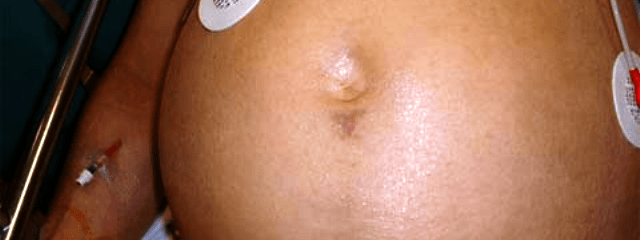Abdominal Compartment Syndrome and Intra-abdominal Hypertension are two sides of the same coin. While Intra-abdominal Hypertension exists when intra-abdominal pressure exceeds the normal level which is set between 20 to 25 mmHg, Abdominal compartment syndrome is said to exist when intra-abdominal hypertension is accompanied by manifestations of organ dysfunction, which dramatically reduces upon abdominal decompression. The organ systems commonly involved include the pulmonary, cardiovascular, renal, splanchnic, musculoskeletal/integumentary (abdominal wall), and the central nervous system.
Certain population groups at particular risk for Abdominal Compartment Syndrome are:
- Severe blunt and penetrating abdominal trauma
- Ruptured abdominal aortic aneurysms
- Retroperitoneal haemorrhage
- Pneumoperitoneum
- Neoplasm
- Pancreatitis
- Massive ascites
- Liver transplantation
- Massive fluid resuscitation
- Accumulation of blood and clot
- Bowel oedema
- Forced closure of a noncompliant abdominal wall
- Circumferential abdominal burn eschars
Epidemiology
- Incidence among those with identifiable risk is 14%, while the incidence following primary closure after repair of ruptured abdominal aortic aneurysm was found to be 4%.
- In the trauma population, those patients undergoing abbreviated or “Damage Control” laparotomy, particularly those with intra-abdominal packing are at an increased risk. Interestingly, an open abdomen does not necessarily mean total absence of the risk of this syndrome.
Signs and Symptoms
- Respiratory Failure that is characterized by impaired pulmonary compliance resulting in elevated airway pressures with progressive hypoxia and hypercapnia. High airway pressures may be needed in this scenario to overcome the high extrathoracic pressure exerted through the diaphragm and not to overcome an intrinsic lung problem. The earliest manifestations of this syndrome may be a subtle pulmonary dysfunction or an elevated peak airway pressure. Elevated hemidiaphragms with a loss of lung volume may be the only sign in an otherwise innocuous patient.
- Haemodynamic Indicators: Elevated heart rate, hypotension, elevated pulmonary artery wedge pressure and central venous pressure, reduced cardiac output, and elevated systemic and pulmonary vascular resistance. A decreased venous return is central to the pathophysiology of abdominal compartment syndrome.
- Renal function impairment is manifested as oliguria progressing to anuria with resultant azotemia. It is only partly reversible by fluid resuscitation.
- Raised intracranial pressure is also another clinical manifestation.
How to Clinically Confirm a Diagnosis of Abdominal Compartment Syndrome
Intra-abdominal Hypertension is present when intra-abdominal pressure exceeds 20 mmHg
- Direct measurement of intra-abdominal pressure by means of an intraperitoneal catheter
- Bedside measurement can be achieved by transduction of pressures from indwelling femoral vein, rectal, gastric, and urinary bladder catheters. Of these, measurement of urinary bladder pressure and gastric pressures are the most common and easily accessible.
- Intragastric pressure measurements are taken from an indwelling nasogastric tube. This varies within 2.5 cm H2O or 1.84 mmHg (conversion factor 1 cm H2O = 0.736 mmHg) of urinary bladder pressures.
In 1984, Kron et al. described a method to measure intra-abdominal pressure at the bedside with the use of an indwelling Foley Catheter as follows:
- Sterile water (50 to 100 ml) is injected into the empty bladder through the indwelling Foley catheter.
- The sterile tubing of the urinary drainage bag is clamped just distal to the culture aspiration port.
- The end of the drainage bag tubing is connected to the Foley catheter.
- The clamp is released just enough to allow the tubing proximal to the clamp to drain fluid from the bladder, then reapplied.
- A 16-gauge needle is then used to Y-connect a manometer or pressure transducer through the culture aspiration port of the tubing of the drainage bag.
- Finally, the top of the symphysis pubic bone is used as the zero point with the patient supine.
A Viable Conclusion
Abdominal Compartment Syndrome is best prevented and any existing predisposing factor is looked into and prevented if possible. It is an important component in the critically ill patients and those with blunt abdominal trauma. One must remember that renal failure due to abdominal compartment syndrome does not respond to fluid resuscitation and should trigger us to consider it in the differential diagnosis. It is imperative that the clinician remains alert to this silent but lurking danger that is Abdominal Compartment Syndrome.

Good articles A++
Thanks Jhonn for your comment. Do keep checking out my blog, and make sure you subscribe. I am sure you will not be disappointed.
Just enabled commentluv! Enjoy
good article. it helped me to understand the symptoms of acute abdominal compartment and its treatment.
This is really one of those rare and extremely informative articles on abdominal compartment syndrome.